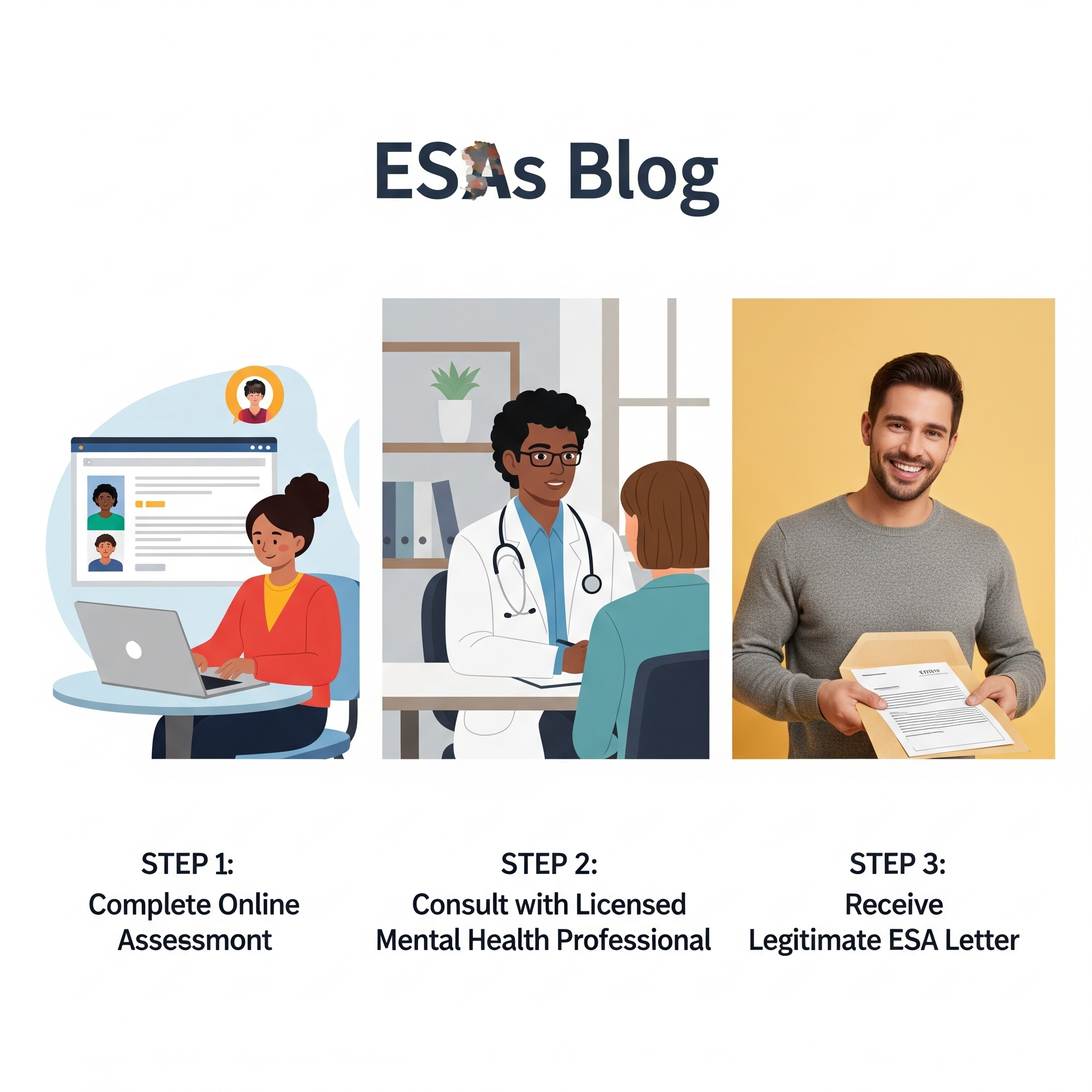For individuals seeking the comfort and support of an animal companion to mitigate symptoms of a mental health disability, the terms “Emotional Support Animal” (ESA) and “Psychiatric Service Dog” (PSD) often arise. While both can be invaluable, their legal definitions, roles, and, most importantly, training requirements are fundamentally different. Navigating these distinctions is crucial for ensuring compliance with federal laws and for securing the appropriate accommodations.
At CertifyESA, your trusted provider of legitimate ESA and PSD letters, we believe in empowering our clients with clear, accurate information. This comprehensive blog post will delve into the profound differences in training requirements for ESAs and PSDs, helping you understand what each entails and why these distinctions matter.
The Core Difference: Presence vs. Performance
The most significant differentiator between an ESA and a PSD lies in their fundamental purpose, which directly dictates their training needs:
- Emotional Support Animals (ESAs): An ESA provides comfort and therapeutic benefit simply through its presence. Their role is to alleviate the symptoms of a mental or emotional disability through companionship and affection.
- Psychiatric Service Dogs (PSDs): A PSD is a working animal. They are specifically trained to perform tasks that directly mitigate a symptom or effect of their handler’s mental health disability. These are tasks the handler cannot perform for themselves due to their disability.
This core difference, “presence vs. performance,” is the bedrock upon which all training requirements are built.
ESA Training Requirements: Minimal, But Recommended
Under the Fair Housing Act (FHA), which primarily governs housing accommodations for ESAs, there are no specific training requirements for an Emotional Support Animal. An ESA does not need to undergo specialized training to perform tasks (U.S. Department of Housing and Urban Development, n.d.). Their therapeutic benefit comes from their inherent nature and the bond with their handler.
What this means for ESAs:
- No Task Training Required: An ESA does not need to be trained to perform any specific “work” or “task” related to a disability. Its mere presence and companionship are sufficient to provide emotional support.
- Any Domesticated Animal: Because specialized training isn’t required, an ESA can be a dog, cat, bird, rabbit, or any other domesticated animal that provides emotional comfort.
- Basic Manners are Highly Encouraged: While not legally mandated for an ESA, responsible ownership dictates that your ESA should be:
- House-trained: This is a fundamental expectation for any animal living indoors.
- Well-behaved: Your ESA should not be aggressive, disruptive, or destructive. Basic obedience commands like “sit,” “stay,” and “come” are highly beneficial for managing your animal in a home environment and preventing issues with landlords or neighbors.
- Non-disruptive: While not a “service animal” in public, a well-mannered ESA is always preferable for harmonious living.
The Role of the ESA Letter: For an ESA, the crucial document is a legitimate letter from a Licensed Mental Health Professional (LMHP). This letter confirms you have a mental health disability and that the ESA provides a therapeutic benefit directly related to that disability, thus qualifying for housing accommodations under the FHA. CertifyESA connects individuals with LMHPs who can provide such letters.
PSD Training Requirements: Extensive and Task-Specific
In stark contrast to ESAs, Psychiatric Service Dogs require extensive, individualized training. The Americans with Disabilities Act (ADA), which governs public access for service animals, explicitly states that a service animal must be “individually trained to do work or perform tasks for the benefit of an individual with a disability” (U.S. Department of Justice, n.d.). This training must be directly related to mitigating the handler’s disability.
What this means for PSDs:
-
Task Training is Mandatory: This is the defining characteristic of a PSD. The dog must be trained to perform specific, observable actions that directly help its handler with their mental health disability. These tasks are not natural behaviors of a pet.
- Examples of PSD Tasks:
- Medication Reminders: Nudging the handler at specific times to take medication.
- Deep Pressure Therapy (DPT): Lying across the handler’s chest or lap to provide calming pressure during anxiety or panic attacks.
- Interrupting Self-Harm: Nudging, pawing, or licking to interrupt dissociative states or self-harming behaviors.
- Room Searches: Entering a room ahead of the handler to alleviate paranoia or fear.
- Guiding/Finding Exits: Guiding a disoriented handler to an exit during an anxiety attack or disassociation.
- Grounding: Providing tactile stimulation (e.g., licking face, pawing) to ground a handler during flashbacks or emotional overload.
- Alerting to Triggers: Nudging or pawing to alert the handler to an impending panic attack or emotional escalation.
- Creating a Buffer: Standing between the handler and others in a crowded space to provide a sense of personal space and security.
- Nightmare Interruption: Waking a handler during a nightmare.
- Examples of PSD Tasks:
-
Public Access Training: Beyond task training, a PSD must be trained to behave impeccably in public environments. This includes:
- Basic Obedience: Mastering commands like “sit,” “stay,” “down,” “come,” and “heel” reliably in distracting environments.
- Non-Disruptive Behavior: Remaining calm, quiet, and unobtrusive in public settings. This means no barking (unless it’s a trained task), no sniffing merchandise or other people, no jumping, and staying close to the handler.
- Housebroken: Absolutely essential for public access.
- Focus: The dog must remain focused on its handler and tasks, even amidst distractions.
-
No Specific Training Certification or Registration Required by ADA: The ADA does not require professional training, certification, or registration for a service animal. An individual can owner-train their PSD. However, the dog must still meet the rigorous behavioral and task-training standards. Many owner-trainers seek guidance from professional service dog trainers to ensure their dog is properly trained for public access and specific tasks.
-
Species Restriction: Only dogs (and in rare cases, miniature horses) can be recognized as service animals under the ADA.
The Role of the PSD Letter: While the ADA does not require a PSD letter for public access, having one from an LMHP can be incredibly beneficial. This letter confirms that you have a mental health disability and that a task-trained PSD is medically necessary to mitigate symptoms of that disability. For air travel under the Air Carrier Access Act (ACAA), airlines may require the DOT Service Animal Air Transportation Form, which asks for a statement from a licensed medical professional verifying the need for a service animal. CertifyESA helps connect individuals with LMHPs who can complete the necessary assessment and provide documentation for legitimate PSDs.
Can an ESA Become a PSD?
Yes, it is possible for an Emotional Support Animal to transition into a Psychiatric Service Dog, but it requires significant commitment to training.
- Clinical Need First: The individual must first be diagnosed with a mental health disability that requires task-specific assistance.
- Temperament Assessment: The ESA must have the right temperament for service work. Not all dogs are suited for the rigors of public access or the demands of service tasks. They need to be calm, resilient, intelligent, and eager to work.
- Extensive Training: The ESA would then need to undergo rigorous public access training and be individually trained to perform specific tasks that mitigate the handler’s disability. This can be done through a professional service dog training program or through dedicated owner-training with professional guidance. This process typically takes 6-18 months or more, depending on the dog and the tasks.
CertifyESA: Your Ethical Partner in Animal Support
At CertifyESA, we understand the nuances between ESAs and PSDs and the distinct requirements for each. Our mission is to provide an ethical, legitimate, and accessible pathway to obtaining the proper documentation from licensed mental health professionals.
- For ESAs, we ensure that your need for emotional support due to a mental health disability is legitimately assessed, resulting in a compliant ESA letter for housing.
- For PSDs, we connect you with LMHPs who can evaluate your mental health disability and the clinical necessity for a task-trained service animal, providing the documentation that supports your journey toward a working partnership.
We do not “certify” or “register” dogs, as these are not legal requirements. Instead, we focus on facilitating the crucial professional assessment that validates your need for an assistance animal.
Conclusion: Understanding the Path to Proper Support
The distinction between ESA and PSD training requirements is not merely semantic; it has significant legal and practical implications for owners. While ESAs offer comfort through their presence and require no specific training for housing, PSDs are working animals that must be individually trained to perform disability-mitigating tasks and behave appropriately in public. By understanding these critical differences and partnering with a reputable service like CertifyESA for your documentation, you can confidently navigate the world of assistance animals, ensuring you receive the appropriate and legally compliant support for your mental well-being.
References:
U.S. Department of Housing and Urban Development. (n.d.). Assessing a Person’s Request to Have an Animal as a Reasonable Accommodation Under the Fair Housing Act.
U.S. Department of Justice. (n.d.). ADA Requirements: Service Animals. Retrieved from https://www.ada.gov/resources/service-animals-faqs/




